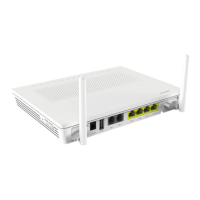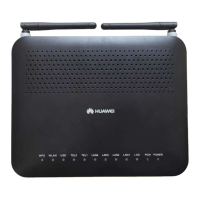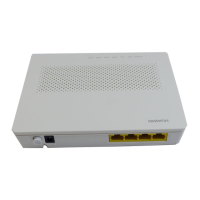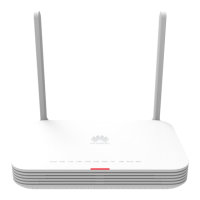Do you have a question about the Huawei FT2050 and is the answer not in the manual?
Displays the front view of the FWT, detailing various ports and indicators.
Lists and describes the function of each port on the FWT, such as antenna, DC input, and data ports.
Explains the function of the voice/fax switch, power switch, and signal strength indicators.
Identifies the wall-mounting brackets used for securing the FWT to a wall.
Locates and describes the slot for inserting the User Identify Module (UIM) card.
Identifies the compartment for housing the FWT's battery.
Identifies the port for connecting the battery.
Identifies the cover for the battery compartment.
Provides instructions and precautions for installing a UIM card into the FWT.
Details the procedure and considerations for installing the FWT's battery.
Instructions for connecting the indoor antenna to the FWT's antenna port.
Explains how to connect one or two telephones to the FWT using its two telephone ports.
Guides on connecting the FWT to a fax machine, noting the fax function's availability.
Details how to connect the FWT to a computer for data services or management.
Explains how signal strength indicators relate to signal reception and network connectivity.
Provides instructions for placing the FWT horizontally on a surface for optimal ventilation.
Details the process of mounting the FWT vertically onto a wall using nails.
Describes the startup process for the FWT and checking signal strength.
Explains the procedures for making and receiving calls, including dialing methods.
Details how to adjust the volume during a call or in standby mode.
Step-by-step guide to adjust in-call volume when the phone is in standby mode.
Instructions for adjusting the in-call volume while actively engaged in a call.
Introduces data services and the necessary software installation.
Guides on installing the modem driver and management program for data services.
Steps to connect the FWT to a computer and access the internet via the management program.
Procedure for sending or receiving faxes using the voice/fax switch.
Procedure for sending a fax when the device does not have a voice/fax switch.
Steps to put the FWT into fax-receiving mode and how to exit it.
Troubleshooting steps if the FWT is powered on but the power indicator is off.
Troubleshooting steps if signal strength indicators are off despite power.
Steps to diagnose and resolve issues where no dial tone is heard after picking up the handset.
Advice on addressing unstable voice quality during calls, related to signal strength.
Guidance on adjusting in-call volume if it's too high or too low.
Steps to take if faxes are not being received by the FWT.
Troubleshooting steps for when calls cannot be answered, possibly due to fax mode.
Possible causes and solutions when sending a fax fails after pressing send.
Explains potential issues with the hands-free function when two phones are connected.
Steps to troubleshoot automatic installation failure of the modem driver.
Precautions regarding using the device when it might interfere with other electronic devices.
Safety advice related to using the device near medical equipment like pacemakers or hearing aids.
Safety guidelines for using the device in areas with potentially explosive atmospheres.
Safety recommendations for using the device while driving or on aircraft.
Advice on suitable operating environments and avoiding conditions that cause malfunction.
Precautions to take during stormy weather with thunder to prevent danger.
Advice on not touching the antenna during calls to maintain quality and battery life.
Emphasizes using only manufacturer-authorized accessories to maintain warranty.
Guidelines for device placement to ensure proper heat dispersal and prevent hazards.
Specifies the minimum safe distance for installing the transmitter's antenna from people.
Recommended ambient temperature ranges for charging and using the device.
Safety precautions to prevent children from playing with the device and accessories.
Reiterates the importance of using manufacturer-supplied accessories to avoid damage or voiding warranty.
Detailed safety instructions and warnings related to handling batteries and chargers.
Information on using the device for emergency calls and its limitations.
Guidelines on proper disposal and recycling of the device and batteries according to WEEE directive.
Information on the device's compliance with REACH and RoHS regulations.
Advisory to observe national local regulations for device usage within the EU.
| Brand | Huawei |
|---|---|
| Model | FT2050 |
| Category | Touch terminals |
| Language | English |











